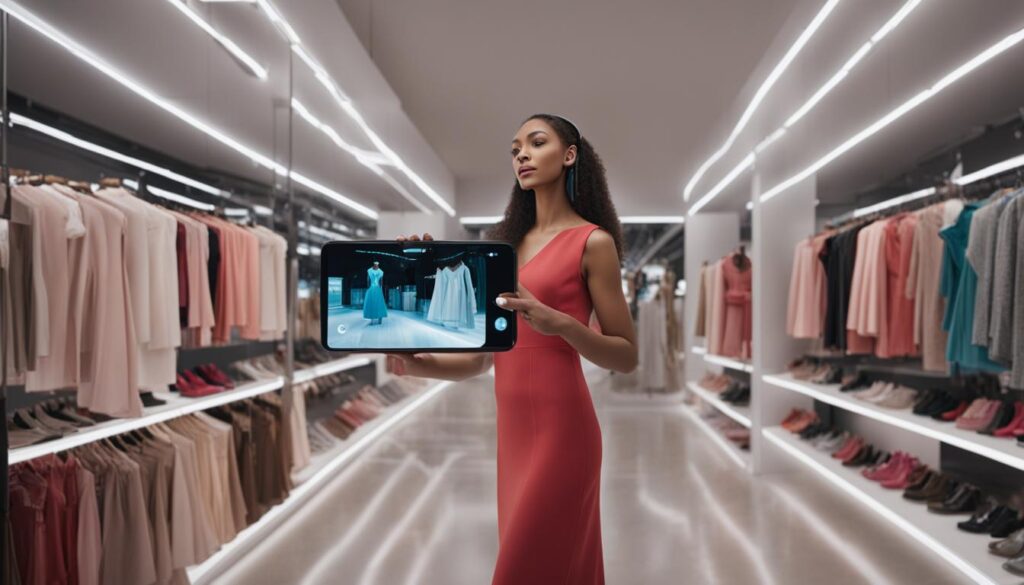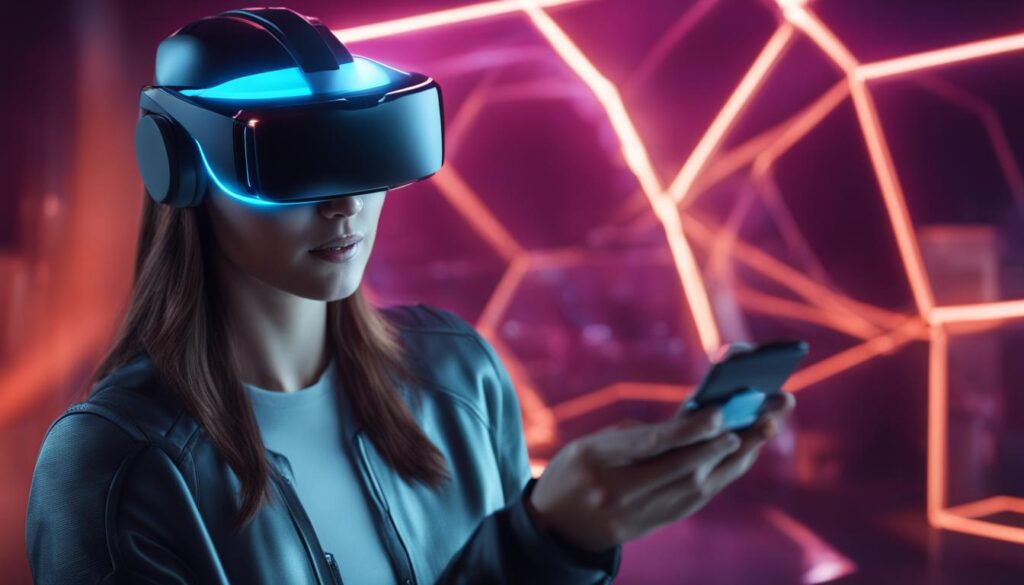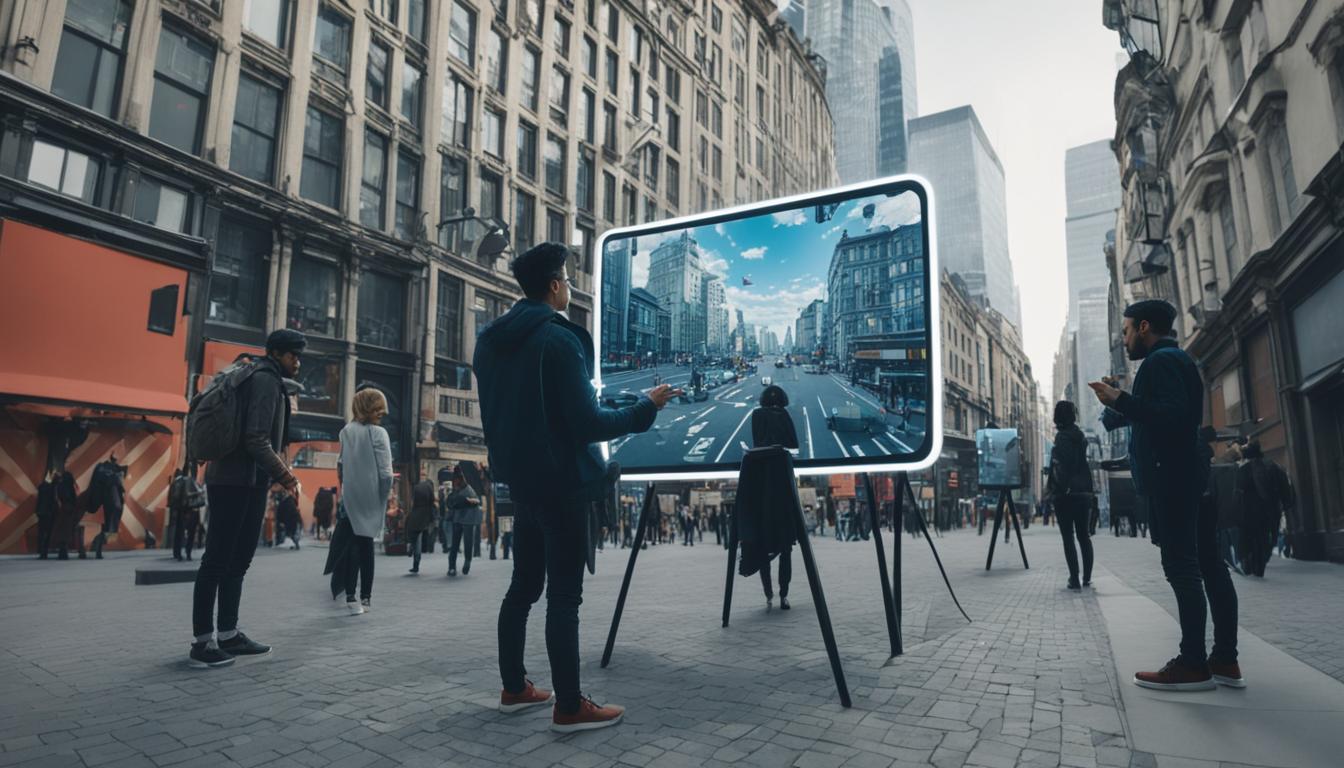Augmented Reality (AR) has the potential to transform our world in ways we can only imagine. As we look towards 2030, the future of AR holds tremendous promise, with advancements that will revolutionize how we interact with technology and the environment around us. From educational experiences to retail applications, AR will shape our daily lives in profound ways.
Imagine a world where you can effortlessly overlay digital information onto the physical world, seamlessly blending the real and virtual. In 2030, AR technology will offer a heightened level of immersion, providing transformative experiences that enhance various sectors, from healthcare to entertainment.
Contents
- 1 The Challenges of Augmented Reality
- 2 Augmented Avatars
- 3 Spatial Audio
- 4 AI Meets Augmented Reality
- 5 Conclusion
- 6 FAQ
- 6.1 What are the challenges of augmented reality?
- 6.2 How is augmented reality being used to create virtual avatars?
- 6.3 What role does spatial audio play in augmented reality?
- 6.4 How is augmented reality being used in retail?
- 6.5 How is artificial intelligence related to augmented reality?
- 6.6 What can we expect from augmented reality in the future?
- 7 Source Links
Key Takeaways:
- The future of AR in 2030 holds immense potential for transformative experiences that will revolutionize industries.
- Advancements in AR technology will enable seamless blending of digital and physical worlds, offering enhanced immersion.
- AR applications will play a significant role in fields like education, healthcare, retail, and entertainment.
- AR in 2030 will provide users with the ability to overlay digital information onto the real world, creating new possibilities.
- As AR technology continues to evolve, it will reshape our daily lives, offering a range of innovative and interactive experiences.
The Challenges of Augmented Reality
Augmented reality (AR) has the potential to revolutionize how we interact with the world around us. However, there are several challenges that have hindered its widespread adoption and realization of its full potential. In this section, we will explore the key challenges that augmented reality faces and how they impact its development and deployment.
AR Hardware Development
One of the main challenges of augmented reality is the development of AR hardware that meets the requirements of comfort, fashion, and provides users with a wide field of view. Current AR headsets can be bulky, heavy, and uncomfortable to wear for extended periods. This has limited their mainstream appeal and adoption. In order for AR to become a ubiquitous technology, the development of lightweight, stylish, and user-friendly AR glasses is essential. Innovative companies like Meta are continuously working on improving AR hardware, aiming to deliver a seamless and immersive AR experience.
Occlusion in AR
Occlusion, the ability to hide digital objects behind real-world objects, is a complex challenge in augmented reality. Achieving realistic occlusion requires precise mapping and tracking of real-world objects, which is not always possible due to the limitations of existing tracking technologies. Without proper occlusion, the digital objects appear flat or float in space, which diminishes the overall immersion and realism of the AR experience. Overcoming occlusion challenges is crucial for creating truly seamless and immersive augmented reality experiences.
Limitations of AR Technology
Despite significant advancements, there are still limitations in AR technology that need to be addressed. These limitations include limited field of view, low resolution, and power constraints. The limited field of view restricts the user’s vision, making it challenging to fully immerse themselves in the augmented environment. Low resolution can result in pixelated and less realistic visuals, impacting the overall quality of the AR experience. Power constraints limit the processing capabilities and battery life of AR devices, affecting their usability and functionality. Continued research and development efforts are focused on overcoming these limitations to enhance the overall AR user experience.
Despite these challenges, the future of augmented reality looks promising. Advancements in AR hardware, combined with innovations in occlusion and addressing the limitations of current technology, are paving the way for smarter and more immersive AR glasses. With improvements in these areas, augmented reality has the potential to transform various industries, from gaming and entertainment to education, healthcare, and beyond.
Augmented Avatars
Augmented reality (AR) technology is rapidly evolving to create immersive digital experiences, and one exciting development is the use of augmented avatars. These avatars allow users to enhance their online presence and express themselves creatively through virtual personas. Whether it’s AR filters on popular social media platforms or WebAR Builder software, augmented avatars are enabling users to interact with digital content in exciting new ways.
![]()
AR filters, popularized by apps like Snapchat and Instagram, have revolutionized how we add virtual objects to our faces in real-time. These filters use advanced AR technology to track facial features and apply entertaining effects, transforming selfies into playful and expressive moments. Users can try on different virtual accessories, experiment with unique hairstyles, or even transform into entirely different characters, all in the blink of an eye.
“AR filters allow users to tap into their imagination and create memorable experiences with friends and followers.”
Additionally, WebAR Builder software has unlocked the potential for displaying augmented avatars in virtual environments. This software enables users to bring their avatars to life and showcase them in various online spaces. By interacting with these virtual environments, users can experience a sense of presence and immersion, blurring the line between the real and the digital.
One practical application for augmented avatars is in virtual meetings. In situations where physical presence is not possible, avatars can serve as representatives, allowing individuals to participate and engage with others remotely. This technology has the potential to revolutionize remote collaboration and make virtual interactions feel more personal and engaging.
Making a Bold Impression: Virtual Avatars in the Entertainment Industry
In the entertainment industry, virtual avatars are gaining popularity as a means of captivating audiences and delivering unique experiences. Musicians like Travis Scott and Lil Miquela have harnessed the power of augmented avatars to create virtual concerts and performances that push the boundaries of traditional live shows.
Virtual avatars provide artists with endless creative possibilities, allowing them to experiment with fantastical visuals and stage designs that would be impossible to reproduce in the physical world. These performers can engage with their fans in unprecedented ways, breaking down geographical barriers and offering immersive experiences that leave a lasting impact.
Overall, augmented avatars are reshaping our digital interactions and offering new avenues for self-expression and creativity. Whether through AR filters or WebAR Builder software, this technology enables users to become whoever they want to be in the virtual realm, opening up a world of exciting possibilities.
Spatial Audio
Spatial audio plays a crucial role in creating immersive AR experiences. It allows you to perceive sound in three-dimensional space, enhancing the overall immersion. Imagine wearing AR glasses and hearing sounds coming from different directions, just like in the real world.
With spatial audio, you can enjoy 3D audio effects that bring a new level of realism to your AR adventures. Whether you’re exploring a virtual world, playing an AR game, or watching AR-enhanced movies, spatial audio enhances the auditory experience and makes it feel more immersive.
“Spatial audio in AR creates a truly transformative experience for users. It adds another layer of realism and engagement, elevating the overall immersive experience to new heights.”
Companies like Meta have developed innovative engines that enable users to mix and create unique audio effects in AR. These technologies allow developers to craft detailed soundscapes that synchronize with the virtual environment, further enhancing the overall user experience.
Immersive audio experiences can transport you to different worlds, evoke emotions, and create unforgettable memories. Whether it’s the sound of rain falling, footsteps approaching from behind, or a distant explosion, spatial audio in AR brings these elements to life, making the virtual world feel more real than ever before.
Benefits of Spatial Audio in AR:
- Enhanced immersion: Spatial audio creates a more realistic and immersive AR experience, making you feel like you’re truly there.
- Improved audio localization: With spatial audio, you can accurately determine the direction from which a sound is coming, adding depth and realism to the virtual environment.
- Engaging storytelling: Spatial audio opens up new possibilities for audio-driven narratives in AR experiences, allowing creators to guide the user’s attention and enhance the storytelling process.
- Interactive soundscapes: Spatial audio enables users to interact with virtual sound sources, creating dynamic and interactive audio experiences.
In conclusion, spatial audio is a game-changer in the world of AR. It has the power to revolutionize how we experience audio in AR, bringing a new level of realism and immersion to our digital adventures. As the technology continues to evolve, we can expect even more impressive audio effects and immersive experiences in the future.
| Advantages of Spatial Audio in AR | Disadvantages of Spatial Audio in AR |
|---|---|
|
|
Why Spatial Audio Matters in AR
Spatial audio is essential in creating truly immersive AR experiences. It adds depth, realism, and a sense of presence, making the virtual world feel more tangible and authentic. Whether you’re exploring an AR museum, attending a virtual concert, or playing an AR game, spatial audio enhances the overall audiovisual experience, taking it to the next level.

Incorporating AR into retail, collectibles, and art brings a new dimension of engagement, interactivity, and personalization to these industries. Whether it’s augmenting product information, showcasing NFT collectibles in real-world settings, offering virtual art experiences, or enhancing the auction process, AR creates transformative experiences that bridge the gap between the digital and physical realms.
| Industry | AR Applications |
|---|---|
| Retail | Interactive product information, augmented shopping experiences |
| Collectibles | Viewing and interacting with NFTs in real-world environments |
| Art | Virtual art experiences, AR-enhanced exhibitions |
| Auctions | AR-infused bidding process, visualizing artwork in personal spaces |
AI Meets Augmented Reality
Artificial intelligence (AI) and augmented reality (AR) are two cutting-edge technologies that are converging to revolutionize the way we interact with digital content and the physical world. By harnessing the power of AI in AR applications, we can unlock a whole new level of performance improvement and transformative experiences.
AI plays a crucial role in enhancing the performance of AR applications by enabling advanced functionalities and addressing challenges such as facial and spatial recognition. Through AI-powered algorithms, AR experiences can be enriched with accurate and real-time information, resulting in improved user interactions and immersive visualizations.
By leveraging AI in augmented reality, developers can create intelligent systems and services that provide users with unprecedented capabilities and seamless integration of digital content into their real-world environments.
One of the key areas where AI shines in AR is facial recognition. By leveraging deep learning algorithms, AR applications can accurately identify and track facial features, allowing for realistic and interactive experiences. This technology has a wide range of applications, from adding virtual makeup or filters to faces in real-time to creating realistic avatar representations for virtual meetings.
Another significant area where AI-powered AR applications excel is spatial recognition. AI algorithms can analyze and understand the physical space, enabling virtual objects to interact with the real environment seamlessly. This opens up opportunities for immersive gaming experiences, virtual furniture placement for home decor, and training simulations for various industries.
AI for AR Performance Improvement
One of the main advantages of integrating AI into AR is the improvement in performance and functionality. AI-powered AR applications can optimize resource management, enhance image and object recognition, and enable real-time scene understanding. This leads to more stable and reliable AR experiences that are capable of handling complex interactions and dynamic environments.
Furthermore, AI algorithms can learn from user behavior and tailor the AR experience to individual preferences, optimizing rendering, and content delivery. This personalization aspect enhances user engagement and satisfaction, making AR a more intuitive and enjoyable technology.
AI-driven performance optimization also extends to AR hardware. By analyzing user input and behavior, AI algorithms can adapt the AR system’s settings and configurations to deliver the best possible experience. This includes optimizing battery usage, adjusting device temperature, and enhancing overall system responsiveness.
The Future of AI-Powered AR Applications
The convergence of AI and AR holds immense potential for the future of technology and innovation. As AI algorithms become more sophisticated and AR hardware continues to improve, we can expect AI-powered AR applications to become even more prevalent in various industries.
Industry leaders such as Microsoft, Google, and Apple are investing heavily in the development of AI-powered AR technologies. From advanced gesture recognition to real-time object detection, these advancements will drive the next wave of AR innovation.
With AI’s ability to process vast amounts of data and make real-time decisions, we can foresee AI-powered AR applications being utilized in fields such as healthcare, engineering, education, and entertainment. From assisting surgeons with real-time visualizations during complex procedures to revolutionizing virtual classrooms with interactive learning experiences, the possibilities are limitless.
Ultimately, the integration of AI and AR is set to transform our daily lives, providing us with enhanced experiences, improved productivity, and greater connectivity with the digital world. By unlocking the full potential of AI in augmented reality. We can expect to witness a new era of intelligent, immersive, and transformative technologies.

Conclusion
Augmented reality (AR) is on the cusp of a groundbreaking transformation in the next decade. It has the potential to revolutionize numerous industries, bringing about a new era of transformative experiences. Despite the challenges AR currently faces, such as hardware limitations and occlusion, its future is incredibly promising. By 2030, AR is expected to become an integral part of our daily lives, reshaping how we interact with technology.
The possibilities of AR are truly exciting. In the field of education, AR can revolutionize classrooms by providing immersive and interactive learning experiences. Students can visualize complex concepts, travel to distant places, and interact with digital objects, making learning engaging and memorable.
In healthcare, AR can enhance medical training, allowing students and professionals to practice complex procedures in a realistic virtual environment. It can also aid in surgeries by overlaying vital patient information onto the surgeon’s field of view, improving precision and patient outcomes.
Furthermore, the retail and entertainment industries can be completely transformed by AR. Shopping experiences can be enhanced with virtual try-ons, personalized recommendations, and immersive product demonstrations. In entertainment, AR can bring characters and stories to life, blurring the line between the physical and digital worlds.
As technology continues to evolve, AR will become more accessible, intuitive, and seamlessly integrated into our daily lives. The future of AR in 2030 holds endless possibilities for enhanced productivity, enriched experiences, and a deeper connection between the physical and digital realms. Get ready for a world where the boundaries of reality are stretched, as transformative AR experiences become the new norm.
FAQ
What are the challenges of augmented reality?
Augmented reality faces challenges in terms of developing comfortable and fashionable AR hardware with a wide field of view. Another challenge is achieving occlusion, which involves hiding digital objects behind real-world objects.
How is augmented reality being used to create virtual avatars?
Augmented reality is being used to create virtual avatars through AR filters, popularized by apps like Snapchat and Instagram. Additionally, WebAR Builder software enables users to display their avatars in virtual environments, creating the illusion of presence.
What role does spatial audio play in augmented reality?
Spatial audio plays a crucial role in creating immersive AR experiences. It allows users to perceive sound in three-dimensional space, enhancing the overall immersion and user experience.
How is augmented reality being used in retail?
Augmented reality is used in retail to display product information such as prices and nutritional content, enhancing the shopping experience. Additionally, AR is being used to view digital collectibles, such as NFTs, in real-world environments.
Artificial intelligence (AI) and augmented reality are closely intertwined. AI algorithms improve the performance of AR applications, particularly in areas like facial and spatial recognition, enhancing user interactions and enabling advanced functionalities.
What can we expect from augmented reality in the future?
Augmented reality holds immense potential for creating transformative experiences in fields like education, healthcare, retail, and entertainment. By 2030, AR is expected to undergo significant advancements and become an integral part of our daily lives, reshaping our world in ways we can only imagine.




